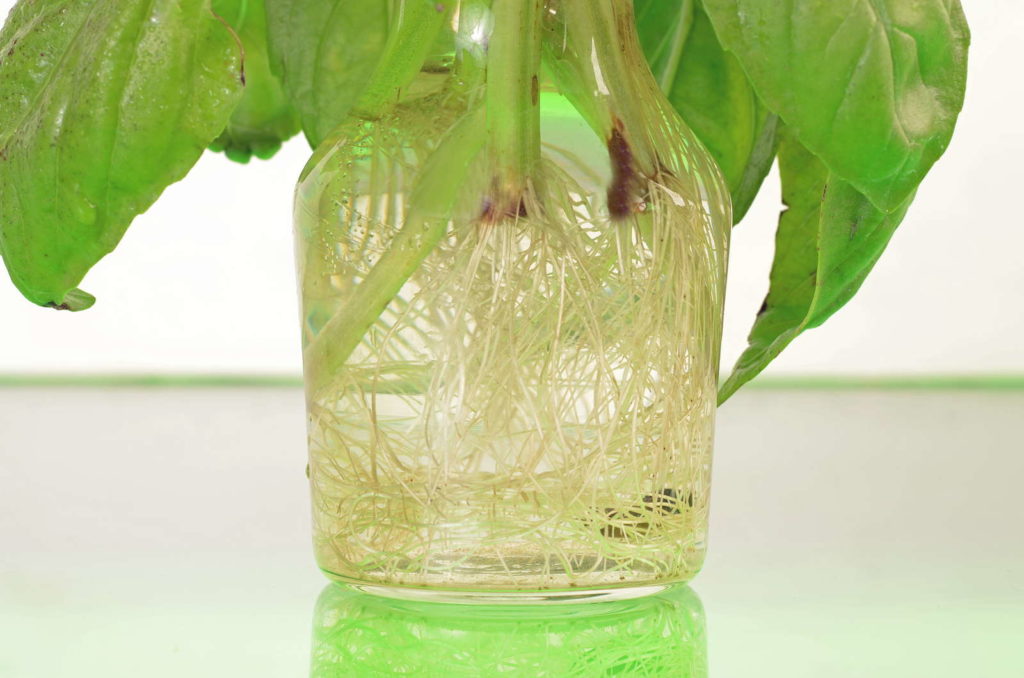Last updated on October 23rd, 2023 at 08:57 pm
Hydroponics, a method of growing plants without soil, offers a perfect environment for cultivating herbs all year round. Whether you’re a culinary enthusiast or simply looking to embrace the joy of homegrown herbs, this guide will introduce you to a selection of herbs that flourish in hydroponic systems. From the classic basil to the unique flavors of cilantro and dill, we’ll explore the benefits of hydroponic herb gardening and provide insights into creating a thriving, indoor herb garden. Get ready to elevate your dishes with fresh, aromatic herbs right at your fingertips. Let’s dive into the world of hydroponic herb cultivation.
7. Basil
Basil (Ocimum basilicum) is probably one of the most popular kitchen herbs. So why not make it stand out with hydroponics? To do this, take a healthy basil plant that has not yet flowered and take cuttings. To ensure that the basil in the water also forms good roots, the cutting should be cut just below a leaf node. Now remove all but the top three or four leaves. In a glass of water in a bright place, the basil now grows and thrives magnificently, if you only change the water every few days.

6. Oregano
Whether with pizza, pasta or meat: oregano (Origanum vulgare) is a real all-rounder. It looks just as good in water as it does in the ground. Simply cut off a few young shoots and place them in water. The most important thing for oregano now is the right temperature and plenty of sunlight. A room temperature around 20 °C and a place at a sunny window are ideal for the oregano to develop. Here, too, the water should be changed regularly.
5. Rosemary
Spicy rosemary (Rosmarinus officinalis) is not only an ideal candidate for the kitchen, but also does well in water. To do this, cut cuttings about 10 to 15 cm long and remove the lower needles. Now the rosemary can already move in the glass. But do not worry if it takes a little time until the first roots appear: Woody cuttings of rosemary are among the cozier colleagues. However, in a sunny place and with regular water changes, rosemary also grows without soil and end.
4. Mint
Mint (Mentha) is not only delicious, it also smells fresh and delicious. So is there a more ideal houseplant? Even more so, you can easily grow it in water. Separate a few shoots and remove the lower leaves from the cuttings. Now the mint only needs water and sunlight. The warmer it is in their environment, the faster the first small roots grow: in ideal conditions, it can take only a few days to see the first successes.

3. Lemon balm
Having lemon balm (Melissa officinalis) in the house is always a good idea: not only does the plant smell wonderfully fresh and is perfect as a seasoning for many dishes. The aromatic smell is also a real mosquito repellent. To be able to grow lemon balm in water as well, it is best to select healthy, green stems. Again, you should remove the lower leaves and then place the plant in water. Lemon balm is particularly sensitive when it comes to stagnant water: so regular change is mandatory for a healthy lemon balm.

2 Stevia
Stevia (Stevia rebaudiana) is known mainly as a sugar substitute rather than a plant. Yet Stevia is a perfect choice for adding natural sweetness to a dish. For successful growing in water, the shoots of the plant should still be quite young before they find their way into the glass as cuttings. Stevia likes especially bright and warm rooms, so a place in front of a sunny window is ideal. Here the plant can thrive and bear its sweet harvest.
1 Sage
As a tea or as a spice, sage (Salvia) is well known. But did you know that you can also grow the green leaves without any soil at all? Cut the young shoots of sage best in the spring and remove the lower leaves. Now the plant only needs regular fresh water (otherwise mold can quickly develop) and a bright place. Soon you will have not only an eye-catcher in the kitchen, but also always a fresh supply of sage leaves.

Of course, all these herbs are also happy to have a place in the bed or flower pot. Especially if larger quantities are to be harvested, cultivation in water is not perfectly suitable.


